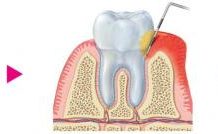There is no reason for healthy gums to be inflamed or bleed. When the bacterial balance in the oral cavity is altered, disease may occur due to the accumulation of microorganisms that form oral biofilm.
Of bacteria-induced periodontal diseases, gingivitis is the most common with a high incidence. Gingivitis appears when supragingival plaque level increases due to poor plaque removal.
This gum disease is reversible and can remain stable for years, but it can also evolve to become periodontitis. This happens when the inflammation spreads to the periodontal ligament, connective tissue and alveolar bone. The gingival epithelium moves along the root surface in a destructive process that causes subgingival pockets to appear and bone and connective tissue to be reabsorbed, finally causing tooth loss.
To prevent and treat these gum diseases, focusing on breaking up and removing biofilm is crucial for ultimately achieving a reduction in the bacteria that cause them, until healthy levels are achieved. This requires the implementation of physio-chemical combined treatments. Physical treatment breaks up the oral biofilm, although it presents certain limitations, which is why the use of chemical adjuncts to mechanical therapy such as antiseptic mouthrinses is so important for biofilm control.
Controlling these diseases is greatly important because of the association they may have with certain systemic disases; periodontal disease can be a risk factor for diabetes mellitus, heart diseases, pulmonary diseases, and others.
It is essential to focus on periodontal health maintenance to prevent the formation of pathogenic biofilm, thereby minimising the risk for gum disease.
 initiative
initiative 
